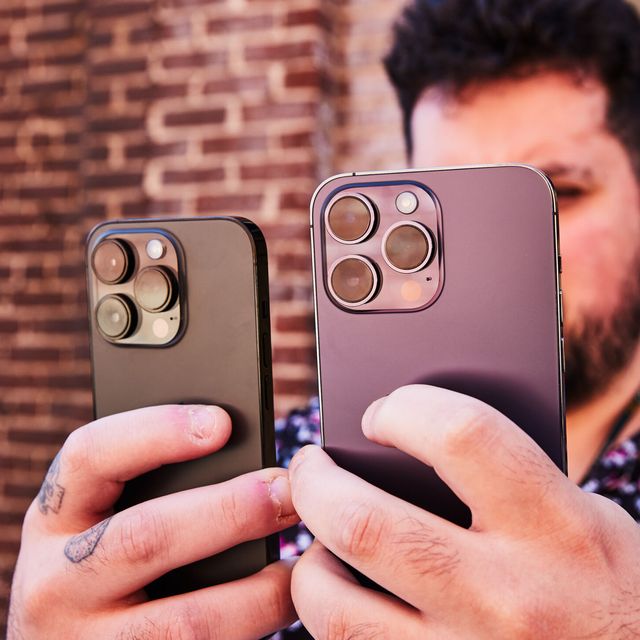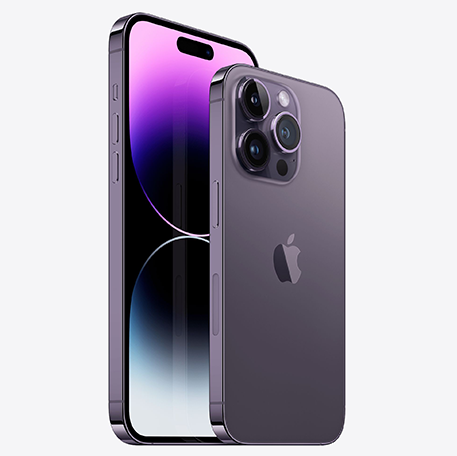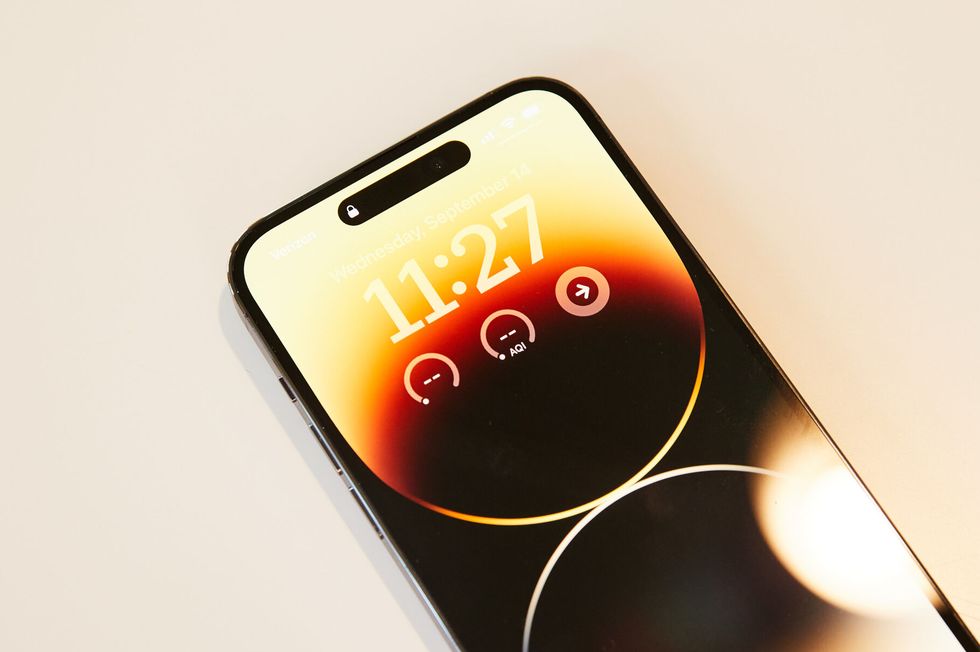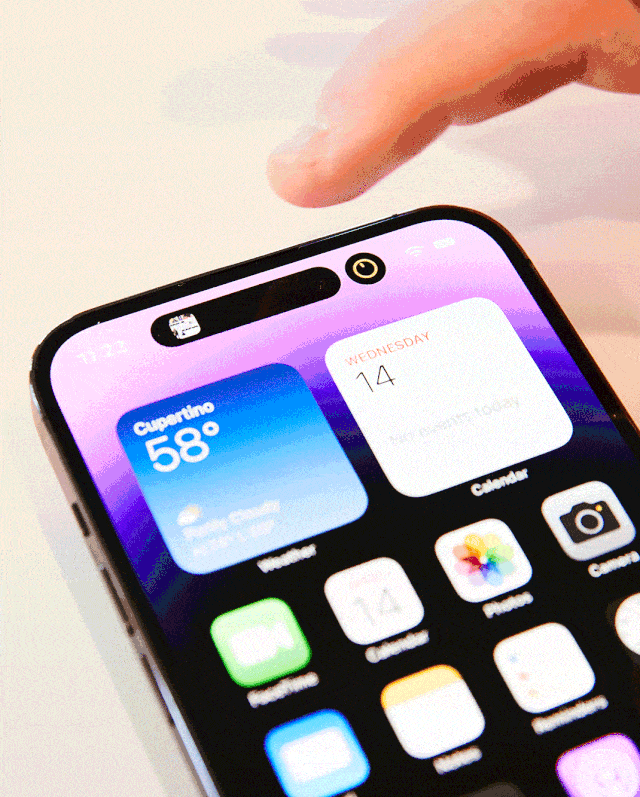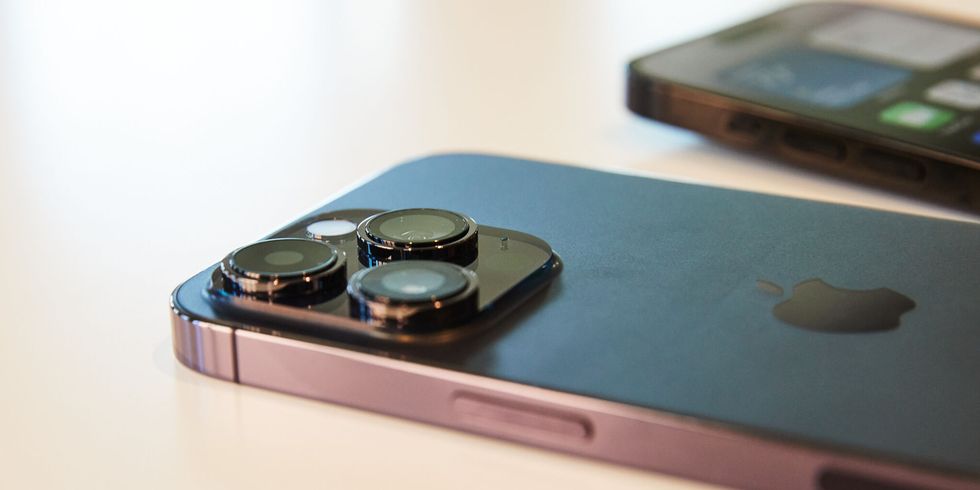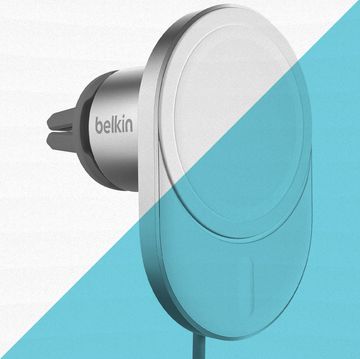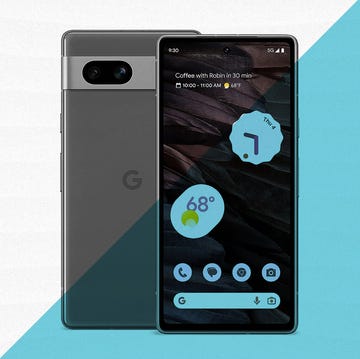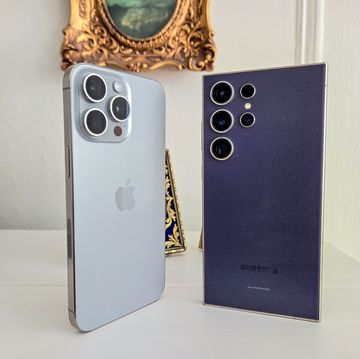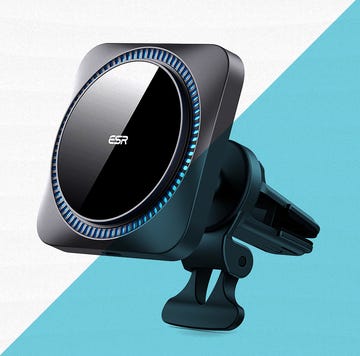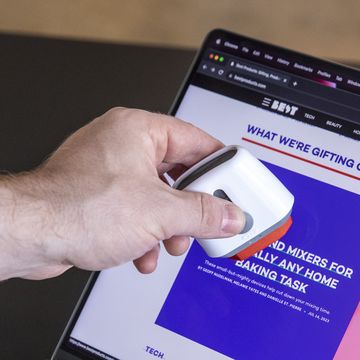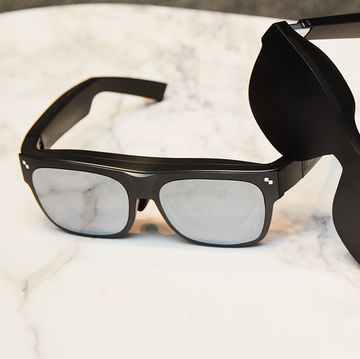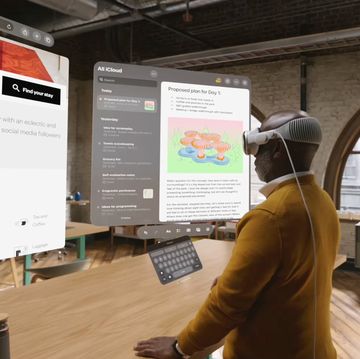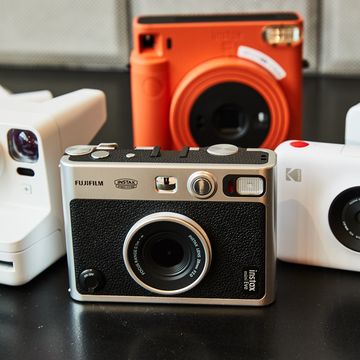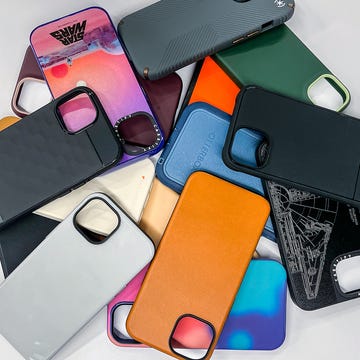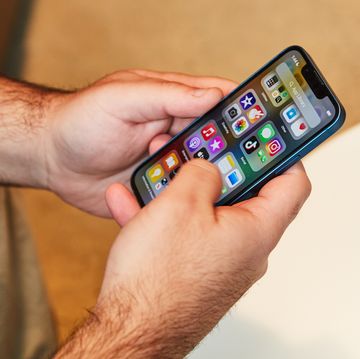The Download
The new 6.1-inch iPhone 14 Pro ($999) and larger 6.7-inch iPhone 14 Pro Max ($1,099), which debuted last week, are the most powerful smartphones on the market. But more than imbuing them with basic performance upgrades, Apple has completely overhauled two core systems: The camera now shoots at 48 megapixels (quadruple that of its predecessor), and the display is brighter, with always-on functionality. We still can’t celebrate the death of the notch—the space-consuming cutout at the top of the screen that houses camera and sensor components. We can, however, toast a long life to Apple’s new Dynamic Island, which replaces the notch with a smaller area that transforms to help you corral and multitask background apps while freeing up the main screen.
These new features are powered by the new A16 Bionic chip, which is exclusive to the iPhone 14 Pro and 14 Pro Max. Though there’s still no 8K video, and the square-edge design is feeling as hefty as ever. We’ve spent the past few days testing both 14 Pro models, putting these phones through their paces with a mix of performance testing like Geekbench 5 for calculating processing power to running tasks like compiling a video with layers of audio and visual effects to gauge speed. That’s in addition to simply browsing the web, playing games, and watching video. To compare how much of a change the 14 Pro is from last year, we used it alongside its predecessor the 13 Pro Max. Read on to see how the iPhone 14 Pro and iPhone 14 Pro Max stack up.
Roomier Always-On Display With A New Multitasking Hub At The Top
Outside of the 14 Pro Max’s bigger screen and battery, this year’s lineup is identical to 2021’s. Both handsets immediately popped out from our test bench with their always-on displays. These new lock screens show information like the time, notifications, and widgets (such as weather, calendar, and phone battery status), even when the phone is asleep. This feature is nothing new—Android phones have had it since the Galaxy S7 in 2016, and Apple itself has implemented it in Apple Watch since the Series 5. While you can deactivate the always-on display from lock screen settings, it had virtually no impact on battery life averages. That’s made possible by a new co-processor and display engine that refreshes at just 1 hertz without taxing primary computing cores.
That 1-hertz rate is exclusive to the A16 chip and is as low as iPhone has gone—previously, the adaptive screen hit just 10 hertz. The iPhone 14 Pro and Pro Max keep last year’s gorgeous 6.1- and 6.7-inch OLED screens, respectively, for sharp colors but further trim down the bezels for more screen real estate. N0w more than ever, Apple is teetering on the edge of an all-screen iPhone. ProMotion dynamic refresh rate tech also makes its return, adapting between frame rates on the fly up to 120 hertz. Anything from scrolling through pages to animations is smoother than the 60 hertz of the base iPhone 14. But if you often watch videos or play games, you really benefit from lower motion blur and controls that feel more responsive. So far, so similar.
But place the 14 Pro and its predecessor side by side, and the differences become stark. High Dynamic Range content looks significantly better this year, as the 14 Pro series reaches 1,600 nits for much richer colors than the high of 1,180 nits on its predecessor. When outside under direct sunlight, its brightness peaks at 2,000 nits and blows away the 13 Pro Max for visibility. But look at the top of the screens and you’ll see the biggest change of all—the notch. Apple’s screen-eating hideaway has shrunk by 30 percent and now consists of a black pill-shaped cut out with a hole-punch camera.
This space on the iPhone 14 Pro and 14 Pro Max is called the Dynamic Island, and it doubles as a control center for background tasks. Text and lively animated graphics fill this space depending on which app you’re running. Holding down this black bubble adjusts and expands your background activity to show more information or pull up controls. For example, when we opened the music app then jumped back to the main screen, the sound wave was condensed to the top. Holding it down opened up play, fast forward, and pause controls. We added a timer to the mix, and it split the Dynamic Island into two bubbles side by side with the sound on the left and countdown in a smaller bubble on the right. Whether we read Google News or scrolled through Twitter feeds, both previous tasks were easily visible and accessible from the top of the display.
But this Island extends to general functionality like displaying the contact info and picture of incoming calls, showing live map directions, and the battery level of connected accessories like AirPods. Developers just received the Dynamic Island toolkit, so more information like live sports scores and ride-sharing statuses will appear here shortly. Even with just native integrations at the moment, the Dynamic Island feels fleshed out, with unique animations and the snappiness with which it opens and condenses on the fly.
Unrivaled Computing Performance Unlocks Faster Speeds and Powerful Features
Everything feels smoother on this iPhone, from swiping through pages to playing intensive 3D games. That’s thanks to the new A16 Bionic chip powering the 14 Pro lineup, which is stronger and smaller than before at 4 nanometers (previously 5 nanometers for the past two years) with even more transistors in a more compact space. This results in faster speeds and better power efficiency that’s noticeable in day-t0-day tasks. Despite the brighter colors and always-on display, the 14 Pro still put up a commendable 12 hours in our battery-life test. We run a 24/7 live YouTube video at 20 percent brightness from a full charge until the phone dies, as this process taxes both the screen and processor with a constant Wi-Fi connection and flow of comments constantly refreshing. On the other hand, the larger 14 Pro Max eked out just over 14 hours, which beats last year’s 13 Pro Max by two full hours. That’s the longest battery life on an iPhone of any generation.
While editing a 15-second video clip with a 7-second sound clip, animated on-screen sliding text, and a fade-to-black transition on the 14 Pro, the new iPhone finished this task faster in just 2.5 seconds versus 4.7 for the 13. And something as simple as loading into an app is much quicker. This was especially noticeable when we played resource-heavy games like Diablo Immortal, which has to check various directories and updates before launching. The performance boost is upwards of 15 percent according to the Geekbench 5 benchmark test, an industry standard when it comes to gauging processing prowess. In this test, a higher score translates to better performance. The A16 put up a score of 1877 in single and 5454 in multi-core performance compared to last year’s A15 Bionic 4659 multi-core. Both Apple chips still beat out the 1323 single-core and 4238 multi-core put out by the comparable Snapdragon 8 Plus Gen 1 powering Android flagships. Apple is touting the strongest mobile chip that is optimized to make the most out of it power.
But graphical performance is just as important as computing power. The iPhone 14 Pro takes full advantage of its high resolution OLED display, earning a 3,369 average score on 3DMark’s Wildlife Extreme test. That’s a 19 percent jump from the 2,729 score put up by the iPhone 13 Pro Max. This boost was especially noticeable when playing 3D games. As we raced around the tracks of Asphalt 9, the little details like the reflection of the sun bouncing off supercars and chunks of body damage from a crash showed in real-time without any frame stutters in 60-FPS mode. Even the most demanding mobile game, Genshin Impact, ran buttery smooth in 120 FPS without chugging. While the 13 Pro could also pull this off, the higher frames often automatically reverted to lower speeds after heavy sessions heated up the phone’s parts. Under the hood, Apple has streamlined the layout for both easy repairability and maximized thermal dissipation to prevent throttling when the phone runs hot.
A 48-Megapixel Main Camera Pairs With A Larger Sensor To Help You Create Professional Photos From Your Pocket
Apple has finally made the leap to a 48-megapixel main camera with this Pro lineup. That’s four times the amount of pixel detail in textures. Combined with a sensor 65 percent larger than the one on the 13 Pro Max, and you get more light for improved shooting in the dark, recreating more accurate colors, and producing all-around cleaner pictures. Compare the RAW shots we took from an iPhone 13 Pro Max and the iPhone 14 Pro Max, and you can make out details like facial hairs and cracks in the wall better on the new camera. You will have to shoot in RAW format to benefit, but even regular photos come out at 48 MP.
While DSLR and mirrorless cameras require you to carry around different lenses to widen your shooting options, the iPhone 14 Pro discreetly packs four lens types—a 13mm ultra-wide, 24mm main, 48mm, and a 77mm telephoto—within its compact triple-lens array. We got a chance to use each while capturing portraits and building architecture. The shots above were taken at 24mm inside of a nearly pitch black recording studio and show the low-light improvements, as the 14 Pro more accurately captures colors and details in the dark. You can see there’s now minimal noise processing, with no airbrush-like smoothing effect on the subject’s face, and the color tones on the shirt and skin are far more lifelike. With the 13 Pro Max, the skin took on a pink tone and the shirt looked much more artificially vibrant.
The only thing that we had hoped for not present on the iPhone 14 Pro is 8K video, a standard on the competing Samsung Galaxy flagships for over two years now. This new camera receives 4K cinematic video for focusing on a subject at up to 30 FPS. Previously, this mode was locked to just 1080p recordings. And a new Action Shot stabilization feature neatly removes shake from hand-captured footage, which is helpful for content creators that find themselves without a gimbal or tripod. You can see the stabilization in action above, where you can clearly see each step we took on the left compared to the smooth glide forward on the right. But ultimately if you’re upgrading for video alone, the 13 Pro Max is still capable.
Connectivity And Safety Features
On Verizon’s 5G Ultrawide Band, we pulled an average download speed of 60 Mbps and 8 Mbps for uploads. That’s optimal for browsing the web and provides a strong foundation for basic phone features like stronger calls and speedy messaging. But it isn’t anything we haven’t seen over the past two years with the introduction of 5G phones. On the other hand, Emergency SOS via Satellite is an exciting development for iPhone 14, which launches in November.
If you try to place a call while off the grid without any Wi-Fi or cellular service, the redial button will turn into a green satellite icon. Giving it a click will launch the Emergency SOS via Satellite feature. We were able to go hands-on with a beta version at Apple Park. You simply tap buttons to answer a quick questionnaire that will streamline the issue you’re having for emergency services (i.e you’re lost, hurt, or have run out of supplies). This message and your current location will be condensed three times smaller than a regular text message and sent over a satellite to an emergency center. All you have to do is point your iPhone toward open sky, and a satellite graphic will help you point in the direction with the strongest connection. It took around 30 seconds to get the message out, but once it is and help is confirmed, you’ll get a text letting you know that assistance is on the way. It’s a well-thought-out feature that was easy to use in our limited experience, but this will be especially helpful for those who often camp or hike in the backcountry. The iPhone’s limited one-day battery life means this won’t be replacing Garmin’s communicators anytime soon, but it will be interesting to see what Apple does with this system going forward.
More people stand to benefit from the new Crash Detection, which can identify when you’re in a severe car accident and alert authorities. Should you get hit, rollover, or crash your vehicle, a new accelerometer and gyroscope built into the hardware will notice up to 256 Gs of force to identify an emergency. This will automatically send a message to authorities and your emergency contacts and is useful in one-way crashes if you’re rendered unconscious.
The Verdict
With a starting price of $999, the iPhone 14 Pro’s 120-hertz screen, 48-megapixel camera, and higher peak brightness offers serious value that’s a major step up from the base iPhone 14 and even last year’s 13 Pro lineup. If you have an even older iPhone (iPhone 12 or below), upgrading to iPhone 14 Pro would provide major improvements with gains in performance, battery life, and display technology, in addition to giving you the Dynamic Island for background app multitasking. Despite a heavy-hitting release with the iPhone 13 Pro, last year, Apple managed to keep the momentum up with a radically more powerful device that goes beyond an incremental upgrade.
Hunter Fenollol, our resident expert of all things consumer tech, from smart home to VR gaming headsets, has years of knowledge creating product explainers, in-depth reviews, and buying guides to help you get the most from the latest electronics. Throughout college, he covered and reviewed the latest gadget releases for sites like Tom’s Guide, Laptop Magazine, and CNN Underscored. If he’s not elbow-deep in the latest hardware, you can find Hunter at one of Long Island’s many beaches, in Manhattan, or gambling away his paycheck.
